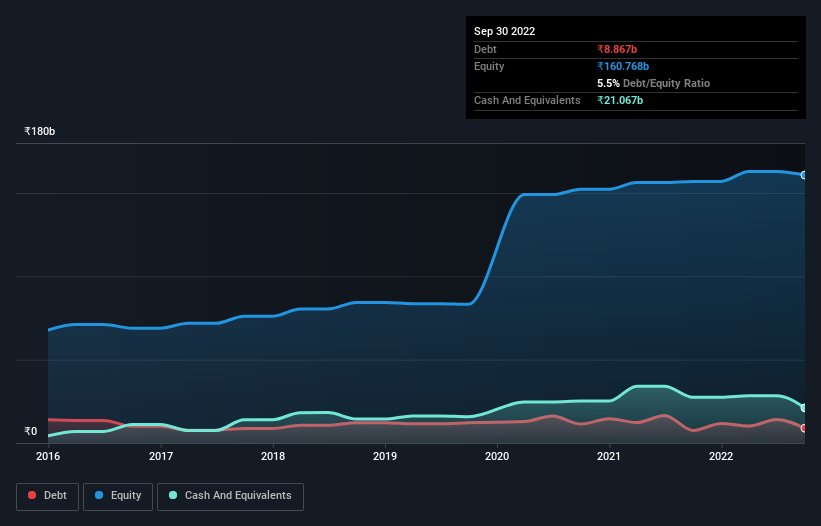We Think Tata Consumer Products (NSE:TATACONSUM) Can Manage Its Debt With Ease

Some say volatility, rather than debt, is the best way to think about risk as an investor, but Warren Buffett famously said that 'Volatility is far from synonymous with risk.' So it seems the smart money knows that debt - which is usually involved in bankruptcies - is a very important factor, when you assess how risky a company is. We note that Tata Consumer Products Limited (NSE:TATACONSUM) does have debt on its balance sheet. But the real question is whether this debt is making the company risky.
Why Does Debt Bring Risk?
Debt is a tool to help businesses grow, but if a business is incapable of paying off its lenders, then it exists at their mercy. Ultimately, if the company can't fulfill its legal obligations to repay debt, shareholders could walk away with nothing. However, a more common (but still painful) scenario is that it has to raise new equity capital at a low price, thus permanently diluting shareholders. By replacing dilution, though, debt can be an extremely good tool for businesses that need capital to invest in growth at high rates of return. When we think about a company's use of debt, we first look at cash and debt together.
Our analysis indicates that TATACONSUM is potentially overvalued!
What Is Tata Consumer Products's Debt?
You can click the graphic below for the historical numbers, but it shows that as of September 2022 Tata Consumer Products had ₹8.87b of debt, an increase on ₹7.53b, over one year. But it also has ₹21.1b in cash to offset that, meaning it has ₹12.2b net cash.

A Look At Tata Consumer Products' Liabilities
The latest balance sheet data shows that Tata Consumer Products had liabilities of ₹30.8b due within a year, and liabilities of ₹16.6b falling due after that. Offsetting this, it had ₹21.1b in cash and ₹16.3b in receivables that were due within 12 months. So its liabilities outweigh the sum of its cash and (near-term) receivables by ₹10.0b.
This state of affairs indicates that Tata Consumer Products' balance sheet looks quite solid, as its total liabilities are just about equal to its liquid assets. So it's very unlikely that the ₹718.3b company is short on cash, but still worth keeping an eye on the balance sheet. Despite its noteworthy liabilities, Tata Consumer Products boasts net cash, so it's fair to say it does not have a heavy debt load!
Another good sign is that Tata Consumer Products has been able to increase its EBIT by 24% in twelve months, making it easier to pay down debt. When analysing debt levels, the balance sheet is the obvious place to start. But it is future earnings, more than anything, that will determine Tata Consumer Products's ability to maintain a healthy balance sheet going forward. So if you're focused on the future you can check out this free report showing analyst profit forecasts.
Finally, while the tax-man may adore accounting profits, lenders only accept cold hard cash. While Tata Consumer Products has net cash on its balance sheet, it's still worth taking a look at its ability to convert earnings before interest and tax (EBIT) to free cash flow, to help us understand how quickly it is building (or eroding) that cash balance. Over the last three years, Tata Consumer Products recorded free cash flow worth a fulsome 91% of its EBIT, which is stronger than we'd usually expect. That positions it well to pay down debt if desirable to do so.
Summing Up
While it is always sensible to look at a company's total liabilities, it is very reassuring that Tata Consumer Products has ₹12.2b in net cash. The cherry on top was that in converted 91% of that EBIT to free cash flow, bringing in ₹9.4b. So is Tata Consumer Products's debt a risk? It doesn't seem so to us. Over time, share prices tend to follow earnings per share, so if you're interested in Tata Consumer Products, you may well want to click here to check an interactive graph of its earnings per share history.
Of course, if you're the type of investor who prefers buying stocks without the burden of debt, then don't hesitate to discover our exclusive list of net cash growth stocks, today.
If you're looking to trade Tata Consumer Products, open an account with the lowest-cost platform trusted by professionals, Interactive Brokers.
With clients in over 200 countries and territories, and access to 160 markets, IBKR lets you trade stocks, options, futures, forex, bonds and funds from a single integrated account.
Enjoy no hidden fees, no account minimums, and FX conversion rates as low as 0.03%, far better than what most brokers offer.
Sponsored ContentValuation is complex, but we're here to simplify it.
Discover if Tata Consumer Products might be undervalued or overvalued with our detailed analysis, featuring fair value estimates, potential risks, dividends, insider trades, and its financial condition.
Access Free AnalysisHave feedback on this article? Concerned about the content? Get in touch with us directly. Alternatively, email editorial-team (at) simplywallst.com.
This article by Simply Wall St is general in nature. We provide commentary based on historical data and analyst forecasts only using an unbiased methodology and our articles are not intended to be financial advice. It does not constitute a recommendation to buy or sell any stock, and does not take account of your objectives, or your financial situation. We aim to bring you long-term focused analysis driven by fundamental data. Note that our analysis may not factor in the latest price-sensitive company announcements or qualitative material. Simply Wall St has no position in any stocks mentioned.
About NSEI:TATACONSUM
Tata Consumer Products
Produces, distributes, and trades in food products in India, the United States, the United Kingdom, and internationally.
Excellent balance sheet established dividend payer.


